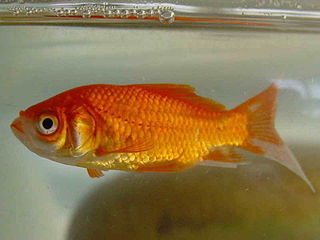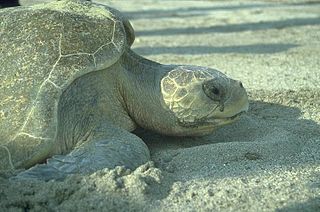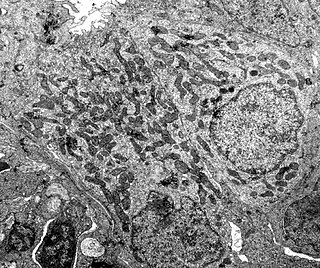Related Research Articles

Salinity is the saltiness or amount of salt dissolved in a body of water, called saline water. This is usually measured in . Salinity is an important factor in determining many aspects of the chemistry of natural waters and of biological processes within it, and is a thermodynamic state variable that, along with temperature and pressure, governs physical characteristics like the density and heat capacity of the water.
Halotolerance is the adaptation of living organisms to conditions of high salinity. Halotolerant species tend to live in areas such as hypersaline lakes, coastal dunes, saline deserts, salt marshes, and inland salt seas and springs. Halophiles are organisms that live in highly saline environments, and require the salinity to survive, while halotolerant organisms can grow under saline conditions, but do not require elevated concentrations of salt for growth. Halophytes are salt-tolerant higher plants. Halotolerant microorganisms are of considerable biotechnological interest.

A gill is a respiratory organ found in many aquatic organisms that extracts dissolved oxygen from water and excretes carbon dioxide. The gills of some species, such as hermit crabs, have adapted to allow respiration on land provided they are kept moist. The microscopic structure of a gill presents a large surface area to the external environment. Branchia is the zoologists' name for gills.

Seawater, or salt water, is water from a sea or ocean. On average, seawater in the world's oceans has a salinity of about 3.5%. This means that every kilogram of seawater has approximately 35 grams (1.2 oz) of dissolved salts. Average density at the surface is 1.025 kg/l. Seawater is denser than both fresh water and pure water because the dissolved salts increase the mass by a larger proportion than the volume. The freezing point of seawater decreases as salt concentration increases. At typical salinity, it freezes at about −2 °C (28 °F). The coldest seawater ever recorded was in 2010, in a stream under an Antarctic glacier, and measured −2.6 °C (27.3 °F). Seawater pH is typically limited to a range between 7.5 and 8.4. However, there is no universally accepted reference pH-scale for seawater and the difference between measurements based on different reference scales may be up to 0.14 units.

The bull shark, also known as the "Zambezi shark" in Africa, and "Lake Nicaragua shark" in Nicaragua, is a requiem shark commonly found worldwide in warm, shallow waters along coasts and in rivers. It is known for its aggressive nature, and presence in warm, shallow brackish and freshwater systems including estuaries and rivers.

In the kidney, the loop of Henle is the portion of a nephron that leads from the proximal convoluted tubule to the distal convoluted tubule. Named after its discoverer, the German anatomist Friedrich Gustav Jakob Henle, the loop of Henle's main function is to create a concentration gradient in the medulla of the kidney.

A contractile vacuole (CV) is a sub-cellular structure (organelle) involved in osmoregulation. It is found predominantly in protists and in unicellular algae. It was previously known as pulsatile or pulsating vacuole.

Tonicity is a measure of the effective osmotic pressure gradient; the water potential of two solutions separated by a semipermeable cell membrane. In other words, tonicity is the relative concentration of solutes dissolved in solution which determine the direction and extent of diffusion. It is commonly used when describing the response of cells immersed in an external solution.

Intertidal ecology is the study of intertidal ecosystems, where organisms live between the low and high tide lines. At low tide, the intertidal is exposed whereas at high tide, the intertidal is underwater. Intertidal ecologists therefore study the interactions between intertidal organisms and their environment, as well as between different species of intertidal organisms within a particular intertidal community. The most important environmental and species interactions may vary based on the type of intertidal community being studied, the broadest of classifications being based on substrates—rocky shore and soft bottom communities.
Euryhaline organisms are able to adapt to a wide range of salinities. An example of a euryhaline fish is the molly which can live in fresh water, brackish water, or salt water.

Osmotic power, salinity gradient power or blue energy is the energy available from the difference in the salt concentration between seawater and river water. Two practical methods for this are reverse electrodialysis (RED) and pressure retarded osmosis (PRO). Both processes rely on osmosis with membranes. The key waste product is brackish water. This byproduct is the result of natural forces that are being harnessed: the flow of fresh water into seas that are made up of salt water.
Enantiostasis is the ability of an open system, especially a living organism, to maintain and conserve its metabolic and physiological functions in response to variations in an unstable environment. Estuarine organisms typically undergo enantiostasis in order to survive with constantly changing salt concentrations. The Australian NSW Board of Studies defines the term in its Biology syllabus as "the maintenance of metabolic and physiological functions in response to variations in the environment".

Stenohaline describes an organism, usually fish, that cannot tolerate a wide fluctuation in the salinity of water. Stenohaline is derived from the words: "steno" meaning narrow, and "haline" meaning salt. Many fresh water fish, such as goldfish, tend to be stenohaline and die in environments of high salinity such as the ocean. Many marine fish, such as haddock, are also stenohaline and die in water with lower salinity.

The salt gland is an organ for excreting excess salts. It is found in elasmobranchs, seabirds, and some reptiles. Sharks' glands are found in their rectum, birds' and reptiles' in or on the skull in the area of the eyes, nostrils or mouth. These glands are lobed containing many secretory tubules which radiate outward from the excretory canal at the center. Secretory tubules are lined with a single layer of epithelial cells. The diameter and length of these glands vary depending on the salt uptake of the species.
Osmoregulation is the active regulation of the osmotic pressure of an organism's body fluids, detected by osmoreceptors, to maintain the homeostasis of the organism's water content; that is, it maintains the fluid balance and the concentration of electrolytes to keep the body fluids from becoming too diluted or concentrated. Osmotic pressure is a measure of the tendency of water to move into one solution from another by osmosis. The higher the osmotic pressure of a solution, the more water tends to move into it. Pressure must be exerted on the hypertonic side of a selectively permeable membrane to prevent diffusion of water by osmosis from the side containing pure water.

Fish gills are organs that allow fish to breathe underwater. Most fish exchange gases like oxygen and carbon dioxide using gills that are protected under gill covers (operculum) on both sides of the pharynx (throat). Gills are tissues that are like short threads, protein structures called filaments. These filaments have many functions including the transfer of ions and water, as well as the exchange of oxygen, carbon dioxide, acids and ammonia. Each filament contains a capillary network that provides a large surface area for exchanging oxygen and carbon dioxide.

Fish physiology is the scientific study of how the component parts of fish function together in the living fish. It can be contrasted with fish anatomy, which is the study of the form or morphology of fishes. In practice, fish anatomy and physiology complement each other, the former dealing with the structure of a fish, its organs or component parts and how they are put together, such as might be observed on the dissecting table or under the microscope, and the later dealing with how those components function together in the living fish.

Shell growth in estuaries is an aspect of marine biology that has attracted a number of scientific research studies. Many groups of marine organisms produce calcified exoskeletons, commonly known as shells, hard calcium carbonate structures which the organisms rely on for various specialized structural and defensive purposes. The rate at which these shells form is greatly influenced by physical and chemical characteristics of the water in which these organisms live. Estuaries are dynamic habitats which expose their inhabitants to a wide array of rapidly changing physical conditions, exaggerating the differences in physical and chemical properties of the water.
The common raven, also known as the northern raven, is a large, all-black passerine bird. Found across the Northern Hemisphere, it is the most widely distributed of all corvids. This article discusses its physiology, including its homeostasis, respiration, circulatory system, and osmoregulation.

An ionocyte (formerly called a chloride cell) is a mitochondrion-rich cell within a teleost fish gill that contributes to the maintenance of optimal osmotic, ionic, and acid-base levels within the fish. By expending energy to power the enzyme Na+/K+-ATPase and in coordination with other protein transporters, marine teleost ionocytes pump excessive sodium and chloride ions against the concentration gradient into the ocean. Conversely, freshwater teleost ionocytes use this low intracellular environment to attain sodium and chloride ions into the organism, and also against the concentration gradient. In larval fishes with underdeveloped / developing gills, ionocytes can be found on the skin and fins.
References
- ↑ McClary, Dr. Marion (August 19, 2008). "Osmoconformer". Encyclopedia of Earth. Retrieved March 13, 2015.
- ↑ Campbell, Neil A.; Lawrence, G. Mitchell; Reece, Jane B. (2000). "Control of the Internal Environment". Biology Concepts & Connections . Benjamin/Cummings. pp. 506–507.
- 1 2 3 4 5 6 Bradley, Timothy J. (2009). Animal Osmoregulation . Oxford University. pp. 58–71.
- ↑ Gibson, Amelia. "Sharks". Sharks Info.
- ↑ Jørgensen, Jørgen Mørup (1998). The Biology of Hagfishes. ISBN 9780412785306.
